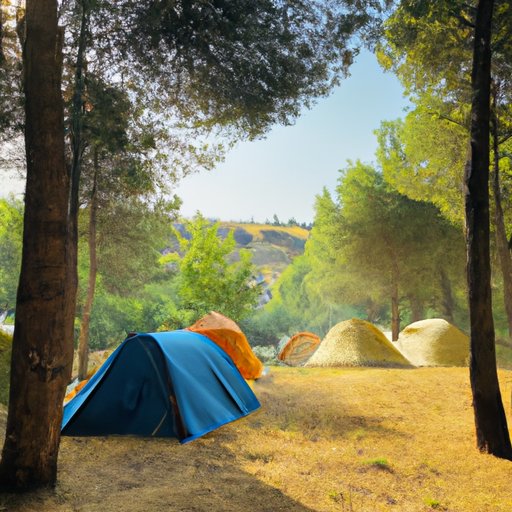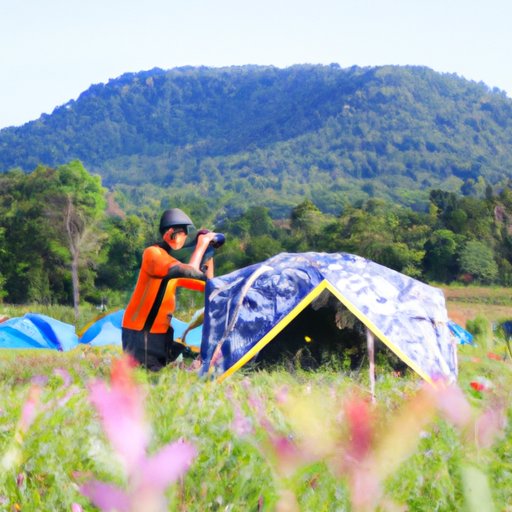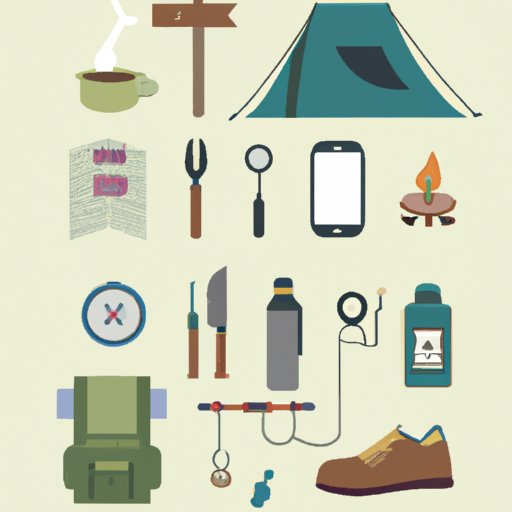Introduction
Camping is a great way to get away from the hustle and bustle of everyday life and reconnect with nature. Whether you’re looking to explore a new area, spend quality time with family and friends, or just relax in the great outdoors, camping trips can provide a much-needed escape. Taking the time to properly plan your camping trip can ensure that it is as enjoyable and stress-free as possible.

Overview of the Benefits of Camping
Camping can provide a variety of physical and mental health benefits. According to a study conducted by the University of Minnesota, “camping has been shown to reduce stress, increase feelings of well-being, and improve sleep quality.” Additionally, spending time outdoors can help boost creativity, enhance concentration, and even reduce symptoms of depression and anxiety. Furthermore, camping is a great way to bond with those around you. As Dr. Christine Carter, author of Raising Happiness, explains, “Being in nature together allows us to enjoy shared experiences and conversations that wouldn’t take place in our day-to-day lives.”
Reasons to Plan Your Trip Carefully
The key to having an enjoyable camping experience is planning ahead. Taking the time to thoroughly prepare for your trip will help ensure that everything runs smoothly. Planning your trip carefully also helps you make the most of your time in the outdoors. With proper planning, you can choose the best campsite, research local attractions, and find the best ways to stay entertained during your trip.
Outline the Essential Gear and Supplies for Camping
Before heading out on your camping trip, it’s important to make sure you have all the necessary gear and supplies. Depending on where you’re going and what kind of activities you plan to do, the items you need may vary. However, there are some basic essentials that everyone should have when camping.
Tents, Sleeping Bags, and Other Necessary Equipment
At the very least, you’ll need a tent, sleeping bags, and a sleeping pad. If you’re camping in cold weather, you may also want to bring along a camping stove and warm clothing. Other pieces of equipment you may need include a first aid kit, a flashlight, a map, and a compass.
Cooking Utensils and Food Supplies
When packing for your camping trip, make sure to bring along any cooking utensils you may need, such as pots, pans, and plates. You’ll also need food supplies, such as canned goods, dried fruit, and nuts. It’s also a good idea to pack plenty of water, as well as snacks for energy throughout the day.
Clothing and Other Personal Items
In addition to the necessary gear and supplies, you should also bring along appropriate clothing and other personal items. Make sure to pack items that are suitable for the climate, such as rain gear if it’s likely to rain. Don’t forget to bring along toiletries, sunscreen, insect repellent, and any medications you may need.

Research the Best Campsites and Locations for Your Trip
Once you’ve gathered all the necessary gear and supplies, it’s time to start researching potential campsites and locations. When choosing a campsite, there are several factors to consider, including local regulations and restrictions, amenities, and accessibility.
Consider Local Regulations and Restrictions
Before selecting a campsite, make sure to check the local regulations and restrictions. In some areas, there may be limits on the number of people allowed at a campsite, or there may be specific rules regarding campfires and alcohol consumption. Be sure to familiarize yourself with the local laws before making any decisions.
Identify Potential Campsites
Once you’ve reviewed the local regulations, you can begin searching for potential campsites. There are many websites and apps available that can help you find campsites in your area. You can also ask friends and family who have gone camping in the past for recommendations.
Evaluate the Amenities of Different Campsites
Once you’ve identified a few potential campsites, it’s important to evaluate the amenities that each one offers. Consider factors such as the availability of running water, toilets, and showers, as well as the proximity to trails, fishing spots, and other attractions. Ultimately, the best campsite is the one that meets your needs and preferences.

Identify and Prepare for Potential Hazards
In addition to researching the best campsites and locations for your trip, it’s also important to identify and prepare for potential hazards. Understanding the weather and climate conditions, becoming familiar with wildlife in the area, and learning about potential natural disasters can help you stay safe while camping.
Understand the Weather and Climate Conditions
Before heading out on your camping trip, it’s important to check the weather forecast for the area. Make sure to bring along items that are suitable for the climate, such as warm clothing and rain gear. It’s also a good idea to bring along a few extra blankets, just in case the temperature drops unexpectedly.
Familiarize Yourself with Wildlife in the Area
When camping in the wilderness, it’s important to be aware of the wildlife that may be present. Research the types of animals that live in the area and learn how to identify them. It’s also important to understand their behavior and the best ways to avoid confrontations.
Learn About Potential Natural Disasters
It’s also a good idea to research potential natural disasters that may occur in the area. For example, if you’re camping in an area prone to flash floods, make sure you know where the nearest shelter is located. Being aware of potential hazards can help you stay safe while camping.
Create a Detailed Itinerary for the Trip
To make the most of your camping trip, it’s important to create a detailed itinerary. This will help you stay organized and ensure that you don’t miss out on any activities or attractions. When creating your itinerary, consider the length of your trip, the route you plan to take, and the activities and attractions you want to experience.
Determine the Length of Your Trip
When planning your camping trip, the first step is to determine the length of your trip. The length of your trip will depend on a variety of factors, such as the location of your campsite, the amount of time you have available, and the type of activities you plan to do.
Map Out Your Route and Stops Along the Way
Once you’ve determined the length of your trip, it’s time to map out your route. Take into account the amount of time it will take to travel to your destination, as well as any stops you plan to make along the way. You may also want to map out alternate routes in case of unexpected delays.
Schedule Activities and Attractions
Finally, it’s important to schedule activities and attractions for your trip. Make sure to research the area and identify the best places to visit. If you’re traveling with others, make sure to involve everyone in the planning process to ensure that everyone has a chance to experience something new.

Consider How to Stay Entertained on the Trip
When camping, it’s important to find ways to stay entertained. Fortunately, there are plenty of activities to keep you occupied during your trip. From playing games to participating in outdoor activities, there are plenty of options to choose from.
Bring Along Games and Books
One of the best ways to stay entertained while camping is to bring along a few board games and books. This is a great way to pass the time and have some fun with family and friends. Card games, puzzles, and word games are all great options.
Participate in Outdoor Activities
Exploring the great outdoors is another great way to stay entertained while camping. Take advantage of the area’s hiking trails, swimming spots, and other attractions. If you’re feeling adventurous, you could even try your hand at rock climbing or kayaking.
Explore the Surrounding Areas
Finally, don’t forget to explore the surrounding areas. Visit nearby towns and cities, or take a day trip to a nearby national park. This is a great way to discover new places and experience different cultures.
Conclusion
Planning a successful camping trip requires a bit of preparation and planning. By taking the time to gather the essential gear and supplies, research the best campsites and locations, prepare for potential hazards, create an itinerary, and stay entertained on your trip, you can ensure that your camping experience is as enjoyable and stress-free as possible.
(Note: Is this article not meeting your expectations? Do you have knowledge or insights to share? Unlock new opportunities and expand your reach by joining our authors team. Click Registration to join us and share your expertise with our readers.)
